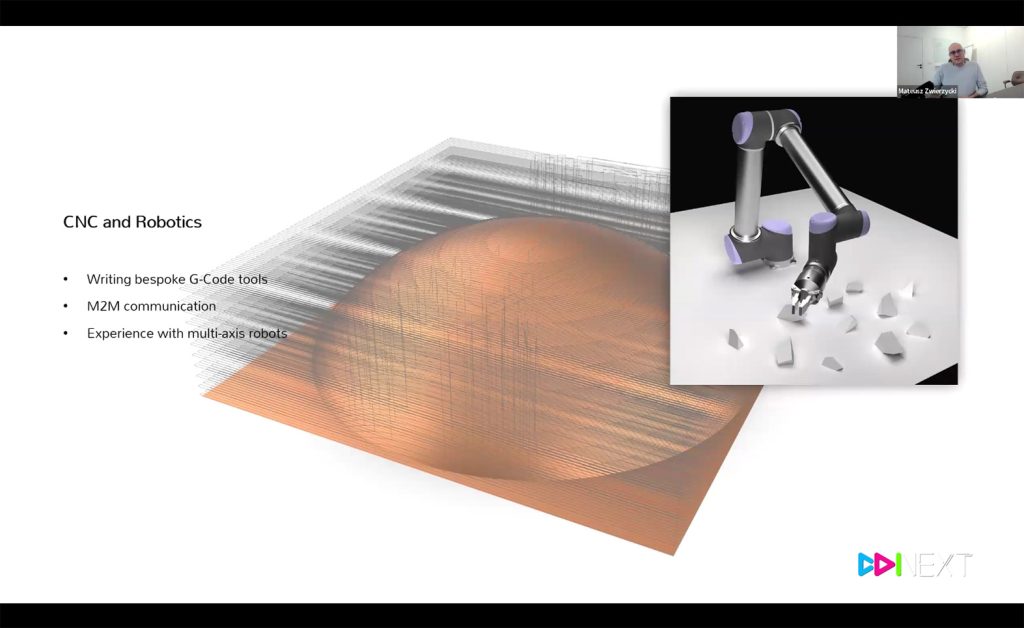CD NEXT 16 conference began with an introductory session by Hamid Hassanzadeh, Founder and Creative Director of Parametric Architecture, and Micheal Pryor, CFO of Design Morphine. They discussed the previous Computational Design: NEXT conference and what we are waiting for in this session.
Computational Design: NEXT is a joint effort by some of the world’s leading experts in computational design to create an online learning platform that serves as a full-fledged online conference. The conference happened on Saturday and Sunday, April 20-21, 2024.
CD NEXT 16 informed designers across various industries. Guests presented the integration of computational design with biomaterials, 3D printing, medical technology, AI-powered visualization, and architectural simulation. Attendees gained valuable insights into collaborative workflows, innovative material applications, and techniques for parametric pattern generation.
Let’s take a look at the key takeaways of CD NEXT 16, and you can also access the recording here.
The conference started with a presentation by Carmelo Zappulla, the founder and managing director of External Reference. He showcased a collection of projects on various scales, from product designs to facade designs. Zapulla highlighted projects they had completed as a team worldwide and External Reference’s contributions to international events such as the Venice Architecture Biennale, Milan Design Week, and Dubai Expo. He also explained the studio’s collaborative approach, working closely with companies worldwide to create cool projects. Additionally, the studio mainly uses 3D printing technologies and innovative tools to bring their ideas to life.
After a short break, we continued with a tutorial from Laura Civetti, a fashion tech designer. She started the tutorial with a short introductory presentation on Biomaterials and Computational Design. During the presentation, she explained how to find alternative materials and the process from material to design. After the presentation, she shared her techniques for using Grasshopper to create surface compositions with her special bio composition recipe.
We had an amazing lecture from Tim Aufdemkamp, an architect at MENSE—KORTE. He shared with us the process from the design stage to the construction of their 3D printing projects and the techniques and methods used. He also gave significant information about the problems and critical details that may be encountered in 3D printing project design and implementation.
Mateusz Zwierzycki is the founder of Object, a company providing services, product solutions, digital fabrication, development, and manufacturing. He started to explain how they started to company in 2015 and what they were doing. He showed a few of their works, such as Qmed for Meyra Group, which was made with fully parameterized 3d models for medical solutions for knees by using Rhino. He explained how they have configured the projects and their workflow.
Alex Wertheim is an engineer and technologist specializing in materials, micro, and nanofabrication. In his tutorial, he used Rhino and Grasshopper to illustrate creating a parametric pattern. Through clear step-by-step instructions, he guided viewers on effectively using these tools. Additionally, he shared insightful problem-solving techniques for overcoming challenges faced in Grasshopper.
During a presentation by Kerenza Harris, the Director of Advanced Technology and Associate Principal at Morphosis, several projects from the firm were showcased, illustrating their unique approach to creating abstract concepts and implementing these concepts in the real world. Harris shared insights into Morphosis’s ability to integrate architecture and technology, highlighting how they use AR and VR tools to present their projects. She also explained how they applied alternative design tools to their works. She continued her presentation with real-world examples such as the how the made facade design of Kolon One & Only Tower in Seoul and the Orange County Museum of Arts in Costa Mesa, CA.
The second day started with Jesper Wallgren, architect and co-founder of Finch; during his presentation, he showed how Finch operates and how it can be integrated with other tools, such as Grasshopper. He explains how the workflow functions and how you can create a simulation of your architectural project. He also highlights the application’s Cloud option, which allows you to share your work with clients or colleagues.
We received a tutorial from Mahdiyar Esmailbeigi, a professional in Rhino and Grasshopper tools and the creator of plugins such as Planthopper, PersianCat, and Seal. In his tutorial, he provided a basic introduction to Grasshopper and its components, such as moving, rotation, cross-product, and more. Additionally, he walked us through the process of visualizing a basic object in Grasshopper, providing step-by-step instructions. Also, he introduced his upcoming plugin.
Ismail Seleit, an architect at Foster + Partners, showcased his innovative approach by integrating AI tools into his design process. He demonstrated how doodles can be transformed into intricate 3D models using AI-generated designs. His presentation also featured a selection of his notable works.
David Mans is a professional with profound expertise in design, development, and education. He explained the tools and workflows that allow multidisciplinary designers to take new approaches, inspiring the next generation to embrace and propel technological advancements. Additionally, David is actively involved in developing and promoting Mesh+, a plugin for Grasshopper/Rhino that improves mesh manipulation capabilities, further expanding the toolkit available to designers for pushing the boundaries of creativity and functionality.
Nefeli Chatzimina is an Architect, Engineer, and Founder of architectScripta. She has led architectScripta to numerous projects and achievements in the past. During her presentation, she showcased one of their latest projects, which featured a unique combination of Francis Bacon’s paintings and AI explorations. She continued with their real-world projects, such as the Butterfly residential block in Athens, where they integrated AI technology.
Join us at the upcoming CD NEXT!
Hamid Hassanzadeh, Founder and Creative Director of PA, and Michael Pryor, Design Director of DesignMorphine, announced Computational Design: NEXT 17. The registration period has begun! The Event will take place on Saturday and Sunday, August 24 – 25, 2024, and will feature a variety of workshops, panel discussions, technology demos, and presentations.
































Leave a comment